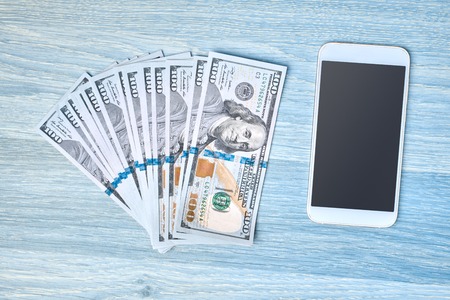Introduction to Expense Tracking in the U.S.
Managing personal finances is a top priority for many Americans, especially with the rising cost of living and changing economic conditions. Keeping track of daily expenses can be challenging, whether it’s groceries, rent, subscriptions, or unexpected bills. Many people find themselves wondering where their money goes at the end of each month. This is where expense tracking apps come in, offering simple and effective tools to help users gain control over their spending habits.
Why Expense Tracking Matters
For most Americans, expense tracking isn’t just about budgeting—it’s about creating peace of mind and building financial security. Here are some key reasons why keeping tabs on expenses is important:
- Preventing Overspending: By monitoring what you spend, it’s easier to avoid going over budget.
- Understanding Spending Patterns: Expense trackers reveal where your money goes so you can make informed decisions.
- Setting and Reaching Financial Goals: Whether saving for a vacation or paying off debt, tracking helps you stay on target.
- Reducing Financial Stress: Knowing your finances gives you more confidence and less anxiety.
Common Financial Challenges in the U.S.
Americans face several everyday financial hurdles that make expense tracking essential:
| Challenge | Description |
|---|---|
| Rising Living Costs | Prices for housing, groceries, and healthcare continue to climb. |
| Debt Management | Many households carry credit card balances, student loans, or car payments. |
| Unexpected Expenses | Medical emergencies, car repairs, or home maintenance can hit anytime. |
| Lack of Savings | A significant portion of Americans have little to no emergency savings. |
How Apps Are Meeting These Needs
The latest expense tracking apps are designed to tackle these challenges head-on by providing features like automatic transaction syncing with banks, customizable spending categories, and easy-to-read charts. Some apps even offer goal-setting tools and bill reminders to help users stay proactive about their finances. With mobile-friendly interfaces and secure data protection, these apps fit seamlessly into busy American lifestyles—making it easier than ever to keep spending in check.
2. Standout Expense Tracking Apps: Key Features
Mint
Mint is one of the most popular expense tracking apps in the U.S., trusted by millions to help manage personal finances. Its main draw is automatic syncing with your bank accounts, credit cards, and even bills. Mint categorizes your transactions, tracks your spending habits, and sends you personalized alerts for upcoming bills or unusual activity. You can also set up simple budgets and see your overall financial health at a glance.
Main Features of Mint:
| Feature | Description |
|---|---|
| Automatic Account Syncing | Connects securely to most U.S. banks and credit cards for real-time updates. |
| Spending Categories | Automatically sorts transactions into categories like groceries, dining, or entertainment. |
| Budget Creation | Helps you set up monthly budgets based on your spending patterns. |
| Bills Reminder | Sends alerts before bills are due to help avoid late fees. |
| Free Credit Score Monitoring | Lets you check your credit score anytime without hurting it. |
You Need A Budget (YNAB)
YNAB stands out for its unique approach to budgeting. Instead of just tracking expenses, YNAB helps you plan how every dollar should be spent ahead of time. It’s designed to encourage users to “give every dollar a job,” which can help with saving more and breaking the paycheck-to-paycheck cycle. YNAB offers educational resources and workshops to boost your budgeting skills, making it a favorite among those looking for hands-on control over their money.
Main Features of YNAB:
| Feature | Description |
|---|---|
| Zero-Based Budgeting | Every dollar gets assigned a purpose, so nothing goes unplanned. |
| Goal Tracking | Easily set and track savings goals for emergencies, vacations, or large purchases. |
| Bank Syncing & Manual Entry | You can sync accounts or manually enter transactions for more control. |
| Real-Time Updates Across Devices | Your budget updates instantly on web, mobile, and tablet devices. |
| Extensive Educational Resources | Tons of free online workshops and tutorials to help you master budgeting. |
Personal Capital (now Empower)
If you’re looking for more than just expense tracking, Personal Capital is a top choice—especially if you want to keep an eye on both day-to-day spending and long-term investments. In addition to basic budgeting tools, Personal Capital gives you an overview of your net worth, investment performance, and retirement planning in one dashboard. It’s ideal for people who want to grow their wealth while staying on top of daily expenses.
Main Features of Personal Capital:
| Feature | Description |
|---|---|
| All-in-One Dashboard | See checking accounts, credit cards, loans, investments, and retirement funds in one place. |
| Investment Tracking Tools | Analyze asset allocation, fees, and performance with easy-to-read charts. |
| Cash Flow & Budgeting Tools | Track income vs. spending automatically and spot trends over time. |
| Retirement Planner | Create personalized projections to see if youre on track for retirement goals. |
| Security & Privacy Focused | Uses strong encryption and multi-factor authentication to protect your information. |
Comparing Key Features at a Glance:
| App Name | Main Focus | Best For | User Experience Highlight |
|---|---|---|---|
| Mint | Simplified tracking & automation | Beginners; quick overviews | User-friendly interface; free to use |
| YNAB | Hands-on budgeting & education | Budgeters who want control | Empowering workshops; real-time sync |
| Personal Capital | Total financial picture + investments | Savers & investors | Diverse tools; strong security |
User Experience Insights:
A lot of users say Mint is perfect if you want a “set it and forget it” tool that handles most tasks automatically. YNAB fans love how it makes them actively think about each purchase—great for getting out of debt or building savings fast. Personal Capital users appreciate seeing everything from checking accounts to 401(k)s in one secure app—making it easier to stay organized as life gets busier. Ultimately, choosing the right app depends on whether you want simplicity (Mint), full control (YNAB), or investment insights (Personal Capital).
![]()
3. Comparison of Usability, Pricing, and Security
Side-by-Side Comparison of Popular U.S. Expense Tracking Apps
If you’re searching for the best expense tracking app in the U.S., it’s important to know how they stack up in terms of user experience, subscription costs, and security features. Here’s an easy-to-understand comparison table that breaks down what you can expect from some of the most popular options on the market.
| App Name | User Experience | Pricing | Security Features |
|---|---|---|---|
| Mint | Intuitive dashboard, automatic syncing, customizable alerts | Free (ad-supported) | 256-bit encryption, multi-factor authentication, Touch ID/Face ID login |
| You Need A Budget (YNAB) | User-friendly interface, hands-on budgeting method, strong community support | $14.99/month or $99/year (34-day free trial) | Bank-level encryption, regular security audits, privacy-first policy |
| Personal Capital | Sleek design, combines budgeting with investment tracking, robust financial tools | Free for budgeting; fees apply for wealth management services | Encryption at rest and in transit, two-factor authentication, continuous monitoring |
| Goodbudget | Envelope-based system, simple setup, great for couples/families sharing budgets | Free (basic); Plus: $8/month or $70/year | SSL encryption, secure cloud sync, no bank connection required for privacy-conscious users |
| PocketGuard | Straightforward overview of spending, “In My Pocket” feature for quick budgeting tips | Free (basic); Plus: $7.99/month or $79.99/year | AES-256 encryption, read-only bank connections, biometric login available on mobile devices |
User Experience Highlights
Mint: Known for its automated syncing with thousands of U.S. banks and real-time alerts for bills and unusual activity.
YNAB: Loved by those who want hands-on control and enjoy learning smarter money habits.
Personal Capital: Great if you want a combined look at your expenses and investments.
Goodbudget: Perfect for envelope-style budgeting fans or anyone who wants to share budgets with a partner.
PocketGuard: Excellent for those who just want a quick glance at their available cash after bills.
Subscription Costs Explained
The range goes from completely free options (like Mint) to paid subscriptions offering more advanced features and ad-free experiences (YNAB and Goodbudget Plus). Most apps offer free trials so you can test them out before committing.
Your Security Comes First
No matter which app you choose, security is a top priority. All these apps use high-level encryption—similar to what banks use—to keep your financial data safe. Multi-factor authentication is standard among most providers. Some apps also let you log in using your fingerprint or face ID on your phone for extra peace of mind.
4. User Experiences and Ratings
When it comes to expense tracking apps in the U.S., real user experiences play a huge role in how people choose the right tool for their financial needs. To give you a better idea of what American users are saying, we’ve gathered feedback from app store reviews, online testimonials, and ratings across popular platforms like Google Play and the Apple App Store.
What Users Like Most
- User-Friendly Interface: Many Americans appreciate apps that are easy to set up and navigate, with clear dashboards and intuitive designs. Apps like Mint and EveryDollar receive high marks for their clean layouts.
- Automatic Bank Syncing: Users love when an app can link to their bank accounts and credit cards automatically, pulling in transactions without manual entry. This feature is especially valued in apps like YNAB (You Need A Budget) and PocketGuard.
- Customizable Categories: The ability to create personal spending categories helps users track their unique expenses, which is a favorite feature among EveryDollar and Goodbudget fans.
- Budget Reminders & Alerts: Notifications for upcoming bills or overspending warnings help users stay on top of their finances, making this feature popular with Americans who want proactive money management.
Common Complaints from U.S. Users
- Subscription Costs: While many apps offer free versions, premium features often require a monthly or annual fee. Some users feel these costs add up, especially if they’re trying to save money.
- Bank Connection Issues: Occasional glitches or delays syncing with certain banks frustrate users who want real-time updates.
- Data Privacy Concerns: Security is top of mind for many Americans. Users sometimes express worries about sharing sensitive financial information with third-party apps.
- Ads in Free Versions: Several free apps display ads, which some users find distracting or annoying.
App Store Ratings Comparison
| App Name | Apple App Store Rating | Google Play Store Rating | Total Reviews (approx.) |
|---|---|---|---|
| Mint | 4.8/5 | 4.4/5 | 800K+ |
| You Need A Budget (YNAB) | 4.8/5 | 4.6/5 | 40K+ |
| PocketGuard | 4.7/5 | 4.2/5 | 35K+ |
| EveryDollar | 4.7/5 | 4.1/5 | 60K+ |
| Goodbudget | 4.7/5 | 4.5/5 | 25K+ |
User Testimonials Highlighting American Preferences
- “I love how Mint tracks my spending automatically—it saves me so much time each month!” – Sarah, California
- “YNAB helped me finally pay off my credit card debt because it made budgeting simple.” – Mike, Texas
- “EveryDollar’s interface is super easy to use, but I wish the free version had more features.” – Jennifer, Florida
- “PocketGuard keeps me from overspending by showing how much I have ‘safe to spend.’ That’s a game changer!” – Kevin, New York City
- “I’m pretty cautious about privacy, so Goodbudget’s envelope system—without linking my bank account—gives me peace of mind.” – Rachel, Illinois
The Bottom Line from U.S. Users’ Perspective
The best expense tracking apps stand out by making budgeting simple, secure, and tailored to American lifestyles. While most users want automation and convenience, cost and data security are key concerns that influence which app they stick with over time.
5. Choosing the Right App for Your Lifestyle
When it comes to managing your money, picking an expense tracking app that truly fits your lifestyle is key. With so many choices on the U.S. market, it can feel overwhelming. Here’s how you can narrow down the best option based on your spending habits, financial goals, and tech comfort level.
Know Your Spending Style
Americans have all sorts of spending habits—some use credit cards for everything, others rely on cash or apps like Venmo. Before choosing an app, think about how you spend your money:
| Spending Habit | Ideal App Features |
|---|---|
| Mainly card-based | Automatic bank syncing, receipt scanning |
| Mostly cash transactions | Manual entry options, split transaction tools |
| Frequent online shopping | E-commerce integrations, real-time notifications |
| Joint or family spending | Shared accounts, multiple user profiles |
Match Your Financial Goals
Your reason for tracking expenses will help determine the right app for you. Are you aiming to save more, pay off debt, or simply see where your money goes? Different apps offer unique strengths:
| Financial Goal | Recommended Features |
|---|---|
| Savings Focused | Budgeting tools, savings goal trackers, alerts for overspending |
| Debt Reduction | Debt payoff calculators, payment reminders, progress charts |
| Simplifying Taxes | Categorized expense reports, export options for accountants |
| Everyday Tracking | User-friendly dashboards, customizable categories, quick add transactions |
Select Based on Tech Comfort Level
The best expense app is one you’ll actually use. Choose an app that matches your comfort with technology:
- If you love tech: Look for apps with advanced features like AI budgeting and smart notifications.
- If you prefer simplicity: Pick apps with clean interfaces and easy setup—no need for a steep learning curve.
- If security matters most: Opt for apps with two-factor authentication and strong privacy policies.
- If you’re often on the go: Mobile-first apps are ideal for busy Americans who track expenses from their phone.
User Experience Tips Across America
- Read reviews from users in similar life stages—college students, parents, freelancers—to see what works best for them.
- Try free versions first to make sure the app feels intuitive before upgrading to premium plans.
- Check if the app connects with popular U.S. banks and financial services for seamless syncing.
- Ask friends or family which apps they use—it’s always good to share tips within your community.
A Quick Checklist Before Downloading:
- Does it support your favorite payment methods?
- Are there hidden fees or subscriptions?
- Can you easily export your data?
- Is customer support responsive if you have questions?
- Will it grow with your changing financial needs?
The right expense tracker should fit naturally into your daily routine and empower you to reach your financial goals—no matter where you are on your money journey in America.


